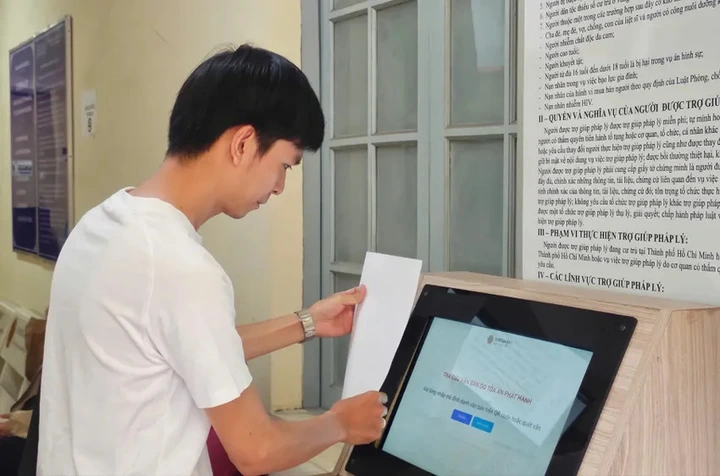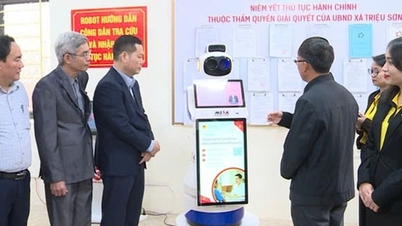
People scan the identification code on the document to compare the issued document with the original document saved in the system.
From traditional court to e-court
Chief Justice Le Thanh Phong said that the two-level Ho Chi Minh City Court has conducted 16,993 online court sessions and meetings in the past five years alone, a record number in the People's Court system. "Technology does not replace justice, but helps bring justice closer to the people," Mr. Phong said.
Since 2021, the Ho Chi Minh City People's Court has proactively developed a project to serve and notify procedural documents via electronic means, a major step forward in reducing administrative procedures. In August 2024, the project was approved by the Supreme People's Court for pilot, paving the way for the "Paperless Court" model.
Citizens can now receive notifications, minutes and court fees electronically on their phones, without having to go to the court. Notably, in the "big vehicle inspection case", the court for the first time applied a combined in-person and online trial model, ensuring security, saving time, while still maintaining the strictness of the law.
When artificial intelligence enters the courtroom
Not stopping at digitizing processes, the People's Court of Ho Chi Minh City also applies AI to "read and understand" case files, a job that takes up most of a judge's time.
The "Virtual Assistant" software can find relevant laws, case law, and cite relevant content with just a few voice commands. A judge can ask: "Which article of the Civil Code does case file 102 on civil contracts violate?" and the system will return an instant answer.
In addition, AI voice recognition is being tested to automatically prepare court transcripts. Instead of secretaries having to type dozens of pages, the entire conversation is converted into text and stored securely.
Chatbot supports people in looking up and guiding them through lawsuit procedures and paying advance court fees; QR codes placed at the reception area help people look up case progress.
"Justice in the digital age is not only reflected in the verdict, but in the transparent operation of the entire system," Judge Phan Sy Hung, District 1 Court, Ho Chi Minh City, affirmed.
In electronic courts, all evidence, from images, videos , and crime scene diagrams, is publicly displayed on a large screen. The parties can observe, compare, and debate directly. According to Mr. Hung, this helps shorten processing time by nearly 40% and creates a "dialogue court", where litigation is considered the center.
The District 1 Court also piloted a system that compares two documents side by side and uses an electronic pen to highlight differences, allowing for visual confrontation. "We no longer have to read the file for 5 minutes and then everyone waits. Now, justice happens right on the screen," he said.
Not only is it faster, e-courts are also safer. All data is processed in a closed internal network, not connected to the Internet, ensuring information confidentiality.
According to Judge Hung, the most important innovation is not in the machines, but in the litigation mindset. The modern court must be a place where the parties can openly dialogue and respect each other, with the judge only playing the role of an arbiter of justice.
"The court is no longer a place to read records, but a place to seek truth through debate," he said.
This change has led to a new court culture, where judges, lawyers and prosecutors use digital platforms to analyze evidence and compare data. Each trial becomes a true "simulation of justice".
"Paperless court" - the destination of 2027
From July 1, 2025, according to Resolution 81/2025/UBTVQH15, the Ho Chi Minh City People's Court system will be reorganized according to a new model: 19 affiliated regional courts. This streamlined structure is the foundation for the goal of an e-Court by 2027.
Ho Chi Minh City People's Court cooperates with the City's Civil Judgment Enforcement Agency to connect data on collection and payment of court fees and charges, helping people pay and receive receipts online.
Lawyer Vu Phi Long, former Deputy Chief Justice of the Criminal Court of Ho Chi Minh City, commented: "These improvements bring great benefits to lawyers and the people. We can look up, submit documents, and participate in trials remotely."
"The Ho Chi Minh City Court is laying the first bricks for a smart court in Vietnam," Mr. Le Thanh Phong affirmed. "Technology can change the way we work, but the people's trust is still the highest measure of justice"./.
Source: https://mst.gov.vn/hanh-trinh-chuyen-doi-so-cua-toa-an-tphcm-197251113090045284.htm




![[Photo] Unique architecture of the deepest metro station in France](https://vphoto.vietnam.vn/thumb/1200x675/vietnam/resource/IMAGE/2025/11/14/1763107592365_ga-sau-nhat-nuoc-phap-duy-1-6403-jpg.webp)


![[Photo] Unique art of painting Tuong masks](https://vphoto.vietnam.vn/thumb/1200x675/vietnam/resource/IMAGE/2025/11/14/1763094089301_ndo_br_1-jpg.webp)


















![[Photo] Special class in Tra Linh](https://vphoto.vietnam.vn/thumb/1200x675/vietnam/resource/IMAGE/2025/11/14/1763078485441_ndo_br_lop-hoc-7-jpg.webp)








































































Comment (0)